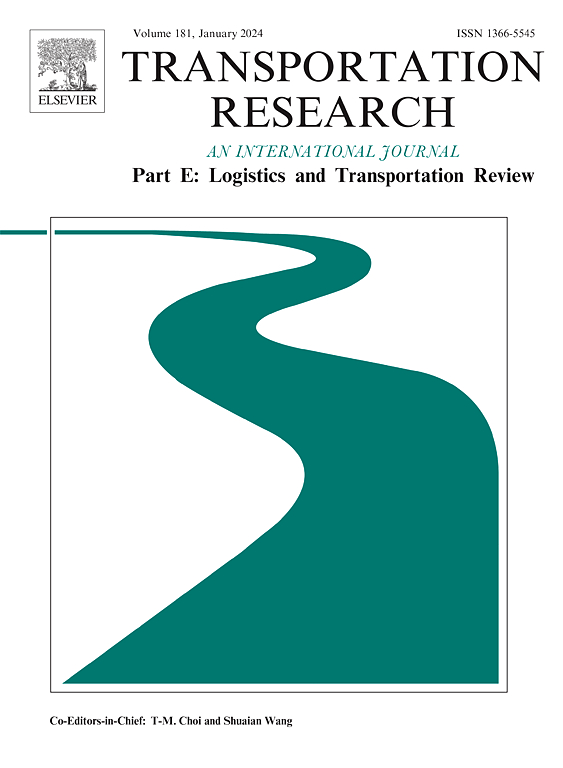Innovations in digital supply chain finance: mitigating payment term and liquidity risks for SMEs
IF 8.8
1区 工程技术
Q1 ECONOMICS
Transportation Research Part E-Logistics and Transportation Review
Pub Date : 2025-08-18
DOI:10.1016/j.tre.2025.104374
引用次数: 0
Abstract
This study develops a two‑stage, game‑theoretic model to analyse how payment term and liquidity risks affect small and medium‑sized enterprises (SMEs) in supply chain finance (SCF). The model simulates a purchase order financing (POF) setting in which suppliers face uncertain payment delays and liquidity constraints, which we model using exponential and Poisson distributions, respectively. Building on this foundation, we evaluate two emerging digital SCF solutions, factoring with smart contracts (FSC) and online invoice trading (OIT), and benchmark them against traditional order‑to‑factoring (OTF). Our model captures strategic interactions between suppliers and retailers under varying risk conditions. The results show that FSC effectively mitigates payment term risk and enables both suppliers and retailers to achieve higher profits than under POF. Moreover, FSC outperforms OTF when the liquidity risk discount exceeds the premium charged for factoring. OIT, which simultaneously addresses both payment term and liquidity risks, consistently delivers the highest value, especially in high liquidity risk environments. While liquidity risk reduces the relative benefit of FSC, it increases the value proposition of OIT. Furthermore, the benefit of mitigating payment term risk initially increases for both FSC and OIT, but this effect tapers off as risk intensity grows. These findings offer practical guidance for SMEs selecting financing strategies under uncertainty, for financial institutions designing responsive SCF products, and for policymakers seeking to narrow the SME credit gap through digital innovation.
数字供应链金融创新:缓解中小企业支付期限和流动性风险
本研究建立了一个两阶段的博弈论模型来分析支付期限和流动性风险如何影响供应链金融(SCF)中的中小企业。该模型模拟了供应商面临不确定的付款延迟和流动性约束的采购订单融资(POF)设置,我们分别使用指数分布和泊松分布对其建模。在此基础上,我们评估了两种新兴的数字SCF解决方案,即智能合约保理(FSC)和在线发票交易(OIT),并将其与传统的订单对保理(OTF)进行比较。我们的模型捕捉了不同风险条件下供应商和零售商之间的战略互动。结果表明,FSC有效地降低了付款期限风险,使供应商和零售商都能获得比POF下更高的利润。此外,当流动性风险折扣超过保理保费时,FSC的表现优于OTF。OIT同时解决了支付期限和流动性风险,始终提供最高价值,特别是在高流动性风险环境中。虽然流动性风险降低了FSC的相对收益,但它增加了OIT的价值主张。此外,减轻付款期限风险的好处最初对FSC和OIT都是增加的,但随着风险强度的增加,这种影响逐渐减弱。这些发现为中小企业在不确定性下选择融资策略、为金融机构设计响应性SCF产品以及为政策制定者寻求通过数字创新缩小中小企业信贷缺口提供了实用指导。
本文章由计算机程序翻译,如有差异,请以英文原文为准。
求助全文
约1分钟内获得全文
求助全文
来源期刊
CiteScore
16.20
自引率
16.00%
发文量
285
审稿时长
62 days
期刊介绍:
Transportation Research Part E: Logistics and Transportation Review is a reputable journal that publishes high-quality articles covering a wide range of topics in the field of logistics and transportation research. The journal welcomes submissions on various subjects, including transport economics, transport infrastructure and investment appraisal, evaluation of public policies related to transportation, empirical and analytical studies of logistics management practices and performance, logistics and operations models, and logistics and supply chain management.
Part E aims to provide informative and well-researched articles that contribute to the understanding and advancement of the field. The content of the journal is complementary to other prestigious journals in transportation research, such as Transportation Research Part A: Policy and Practice, Part B: Methodological, Part C: Emerging Technologies, Part D: Transport and Environment, and Part F: Traffic Psychology and Behaviour. Together, these journals form a comprehensive and cohesive reference for current research in transportation science.

 求助内容:
求助内容: 应助结果提醒方式:
应助结果提醒方式:


